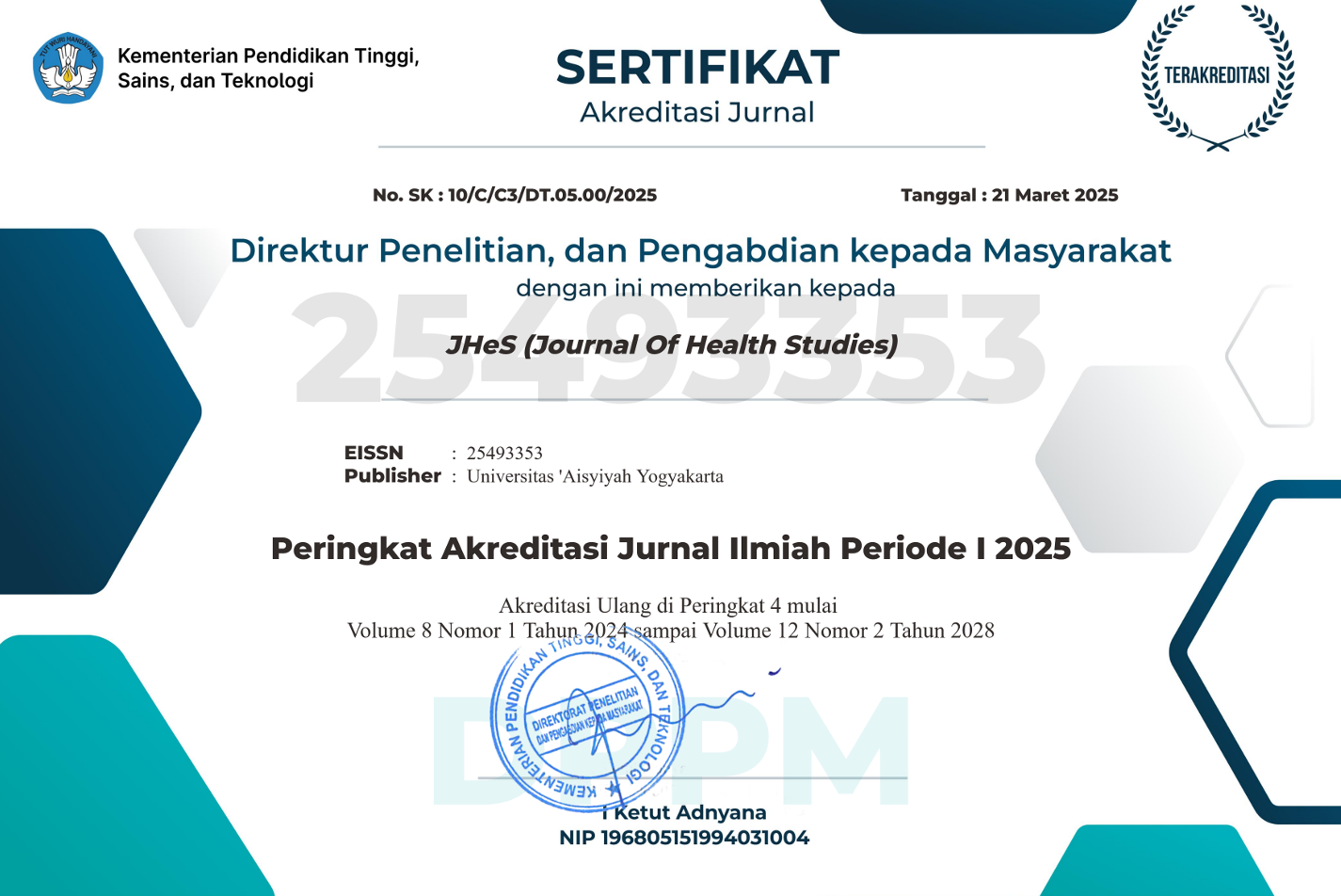Reliabilitas Kaliper Tinggi Lutut dalam Penentuan Tinggi Badan
DOI:
https://doi.org/10.31101/jhes.437Abstract views 2343 times
Keywords:
knee height calliper, body heightAbstract
Downloads
References
Ariyani DE. 2012. Validitas Ukuran Lingkar Lengan Atas terhadap Indeks Massa Tubuh dalam Mendeteksi Risiko Kekurangan Energi Kronis pada Wanita (20-45 Tahun) di Indonesia. Skripsi Diterbitkan. Program Studi Ilmu Gizi Universitas Indonesia:Jakarta.
Berg VD, Dannhauser A, Nel M.2010. Agreement Between Estimated and Measured Heights and Weights in Hospitalised Patients – A Restrospective Study. S Afr J Clin Nutr, 23 (1): S73-S74.Chumpathat N, Rangsin R,
Changbumrung S, Soonthorn N, Durongritichai V, Kwanbunjan K. 2016. Use of Knee Height for the Estimation of Body Height in Thai Adult Women. Asia Pac J Clin Nutr, 25 (3):444-451.
Ercan I, Yacizi B, Ocakoglu G, Sigirli D, Kan I. 2007. Review of Reliability and Factors Affecting the Reliability. InterStat, StatJournals, April 2007.
Fogal AS, Franchescini SCC, Priore SE, Cotta RMM, Ribeiro AQ. 2015. Stature Estimation Using the Knee Height Measurement amongst Brazilian Elderly. Nutricion Hospitalaria, 31 (2):829-834.
Hirani V and Mindell J. 2008. A Comparison of Measured Height and Demi-Span Equivalent Height in the Assessment of Body Mass Index among People Aged 65 Years and Over in England.Age and Ageing, 37: 311-317.
Kuiti B and Bose K.2016. Predictive Equations for Height Estimation Using Knee Height of Older Bengalees of Purba Medinipur, West Bengal, India. Anthropological Review, 79 (1):45-57
Marais WCD, Marais ML, Labadarois D. 2007. Use of Knee Height as a Surrogate Measure of Height in Older South Africans. South African Journal of Clinical Nutrition, 20 (1): 39-44.
Melo APF, Salles RK, Vieria FGK, Ferreira MG. 2014. Methods for Estimating Body Weight and Height in Hospitalized Adults: a Comparative Analysis. Rev Bras Cineantropom Desempenho Hum, 16(4):475-484.
Murbawani EA, Puruhita N, Yudomurti. 2012. Tinggi Badan yang Diukur dan Berdasarkan Tinggi Lutut Menggunakan Rumus Chumlea pada Lansia. Media Medika Indonesiana, 46 (1): 1-6.
Ngoh HJ, Sakinah H, Harsa AMS. 2012. Development of Demispan Equations for Predicting Heightamong the Malaysian Elderly. Mal J Nutr, 18 (2):149-159.
Rabito EI, Vannucchi GB, Suen VMM, Neto LLC, Marchini JS.2006. Weight and Height Prediction of Immobilized Patients. Rev Nutr, 19 (6): 655-661.
Salim OC, Kusumaratna RK, Sudharma NI, Hidayat A. 2006. Tinggi Lutut sebagai Prediktor dari Tinggi Badan pada Lanjut Usia. Universa Medicina, 25 (1): 15-21.
Sugiyono. 2005. Statistika untuk Penelitian. Alfabeta: Bandung. Waningen A. 2009. Measuring Physical Fitness in Persons with Severe or Profound Intellectual and Multiple Disabilities. Journal of Intellectual Disability Research, 53 (4): 377-388.
Downloads
Published
Issue
Section
License
With the receipt of the article by the Journal of Health Studies Editorial Board and the decision to be published, then the copyright regarding the article will be diverted to Journal of Health Studies. Universitas 'Aisyiyah Yogyakarta as the publisher of Journal of Health Studies hold the copyright regarding all the published articles in this journal.
Journal of Health Studies is licensed under a Creative Commons Attribution-ShareAlike 4.0 International License.













